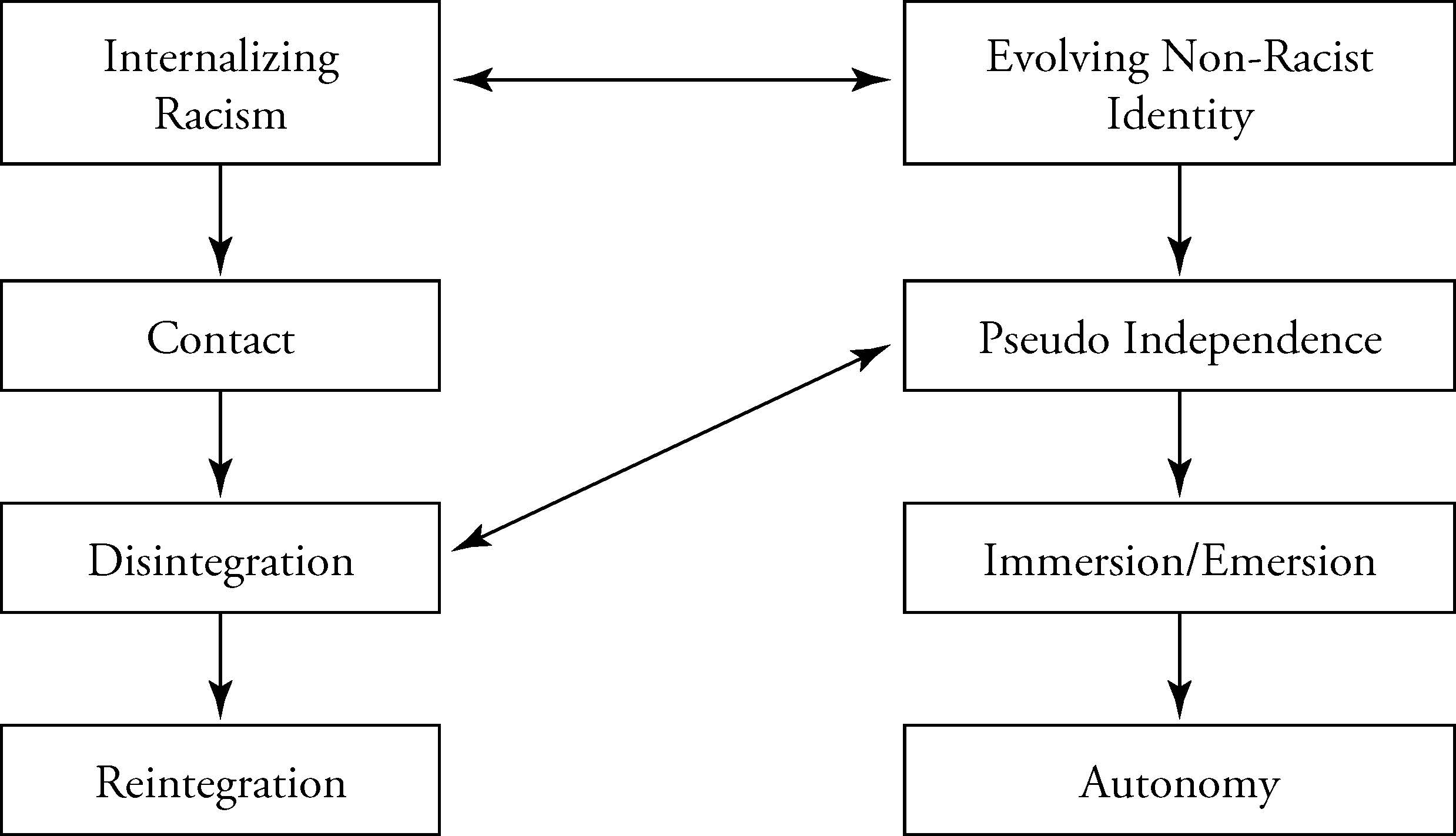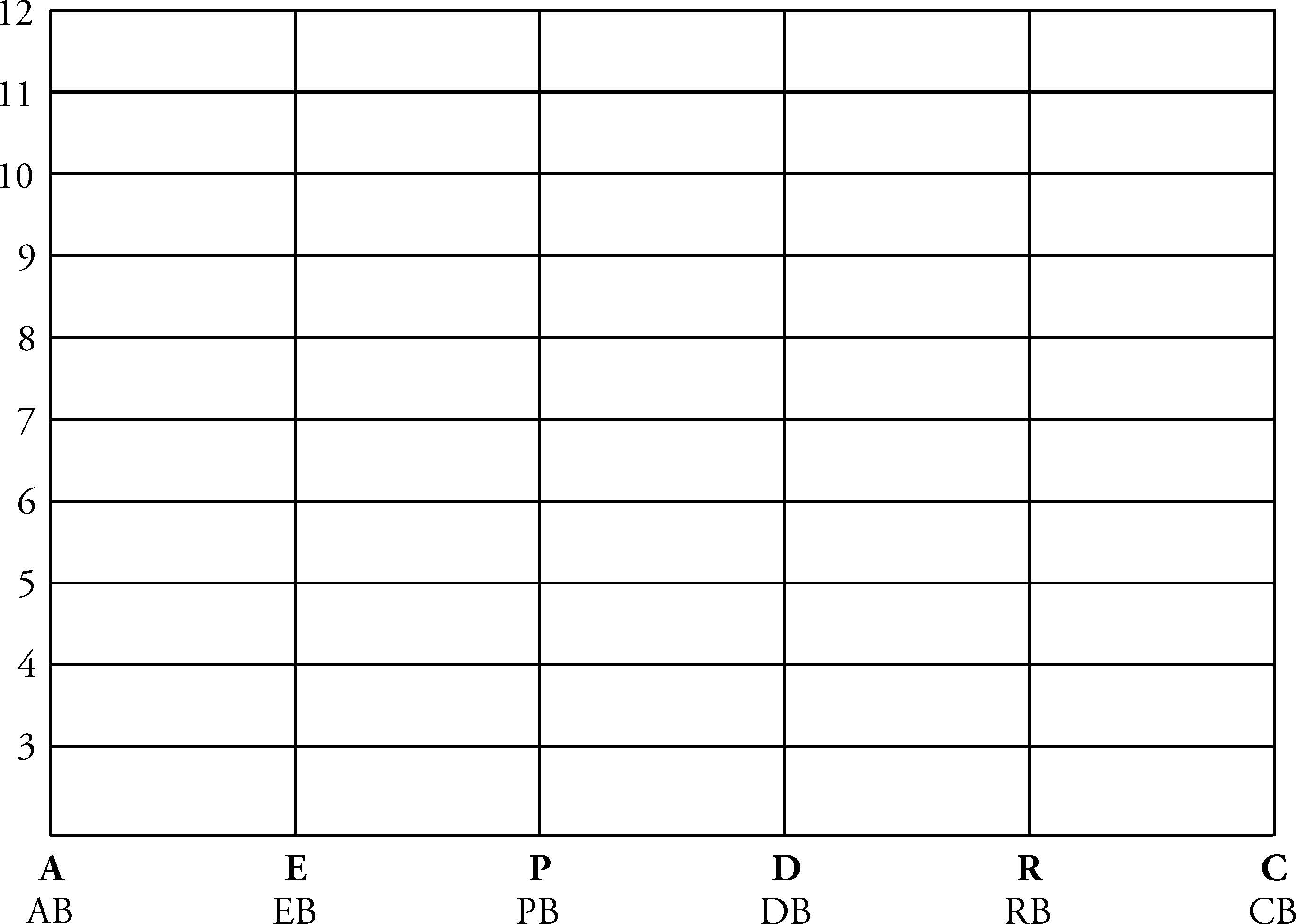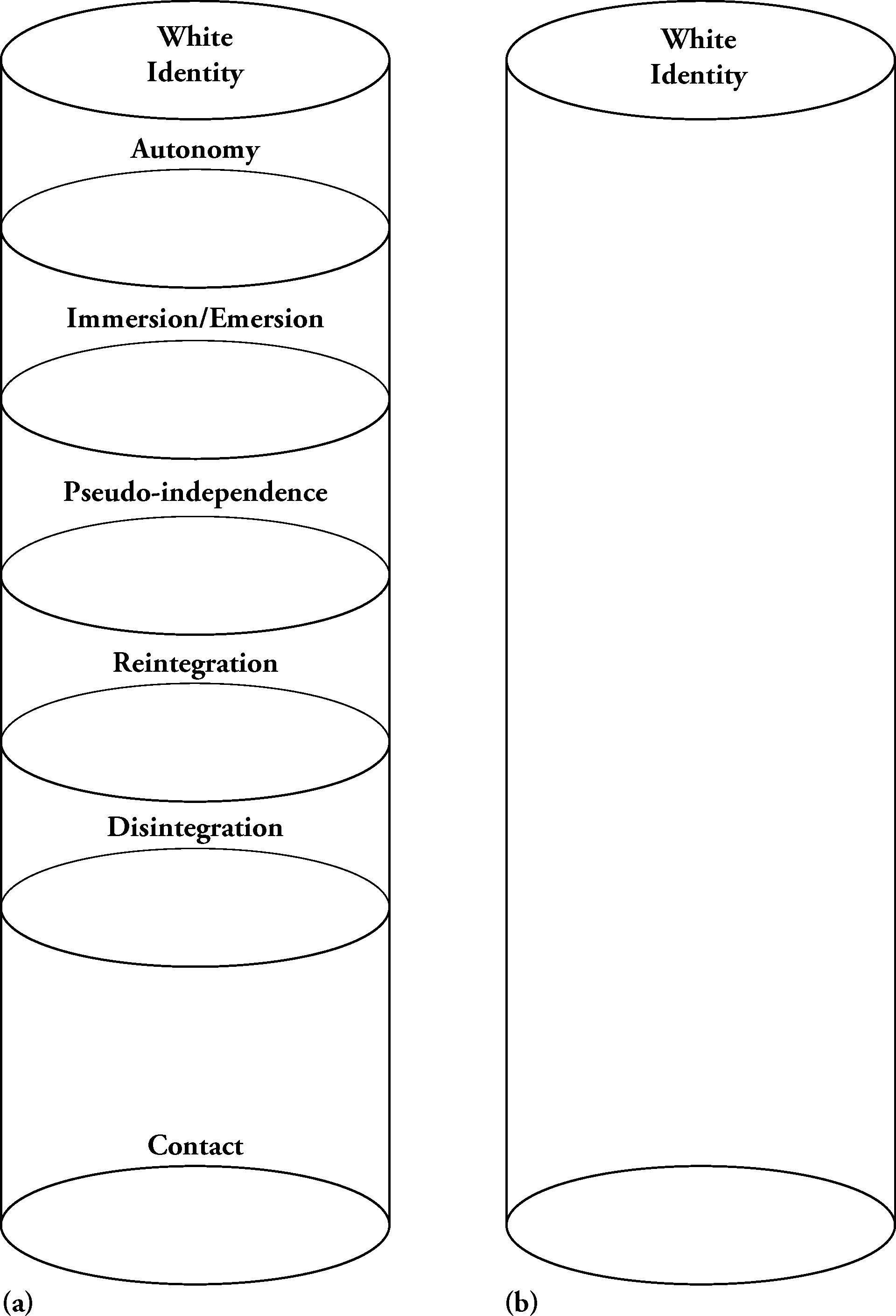3 Reading 1.3: A Model of White Identity Development
Imagine that your daughter or best female friend (or whoever functions in that role for you) announces one day, “Surprise, I’m getting married to someone of another race!” What do you think? What do you feel? What do you say to her? Now, she says, “Oops! I made a mistake; I am getting married, but it’s to someone of our race.” What do you think, feel, and say?
Examine your responses. Did your reactions to the situations change? Chances are they did. But it does not matter if they did not. Racial identity theory deals with how you perceive yourself as a racial being (Who did you think of when she said “our race?”) as well as how you perceive others racially (Who represents “another race” to you?). One’s thoughts, feelings, and behaviors are influenced by how one “identifies” with respect to racial matters.
What did you say to your daughter/friend? What did you feel? Probably, you noticed that each of these dimensions—feelings, attitudes, and behaviors—can be positive, negative, or somewhere in the middle. Perhaps you were also surprised to notice the quality and/or intensity of your reactions. Racial identity theory in general attempts to provide a framework for understanding these reactions. White racial identity theory attempts to provide a framework that makes sense in light of the socialization and common life experiences of White people.
In my model of White racial identity development, I suggest that a healthy White identity potentially develops via a two phase process, internalization of racism and evolution of a nonracist White identity. Each of these phases is hypothesized to consist of three schemas. Think of a racial-identity schema as a pair of eyeglasses or contact lenses through which the person perceives or reacts to racial aspects of oneself as well as events in one’s social contexts. The schemas are not mutually exclusive. So, just as a person may wear more than one pair of eyeglasses (e.g., prescription glasses and sunglasses) at a time, so too may the person use more than one schema at a time to react to racial issues.
Nevertheless, most people have a preference—the schema that works best for them or that they are accustomed to using. In this chapter, I will briefly present the structure of the model. In subsequent chapters, I will present a more detailed discussion of each schema. Figure 1a illustrates the components of the model.

The Contact schema is the foundation of White identity. Engagement in the process of developing a nonracist identity requires individuals to overcome the natural tendency of White people to be oblivious or neutral toward racial issues because of their privileged status. Schemas, characterized as internalizing racism (Contact, Disintegration, and Reintegration) are used to maintain the status quo. Schemas characterized as critical to the evolution of a nonracist White identity (Pseudo Independence, Immersion/Emersion, and Autonomy) require challenging some aspect of White racial socialization norms. Often feelings associated with Disintegration serve as catalysts for this evolution.
In this country, every White person is born into or immigrates into a society in which it is better to be perceived as White than not. This norm is a racist orientation. However, it is so subtle, pervasive, and ever present that it is possible for White people to ignore or deny it. To the extent that this denial persists, it is not possible to develop a healthy White non-racist identity though, in truth, many White people seem to function quite well without one. The internalization of racism phase involves internalization of the rules of racism and the evolution of self-protective strategies to maintain the benefits of White privilege.
The first schema of White identity development is Contact. Contact is characterized by an innocence, ignorance, or neutrality about race and racial issues. The person is not consciously White and assumes that other people are “raceless,” too, with the exception of minor differences in coloration. Contact people generally present a picture of either naïve curiosity or timidity about other races. Contact ceases to be an effective schema when the person is forced to face the political implications of race in this country. Alternatively, in a personally meaningful situation, the person may reach a level of maturity that allows the person to understand the consequences to a White person of offending other Whites. Contact is disrupted if the person cannot find a way to avoid or lessen the internal tension that arises because of this new awareness. The primary self-protective strategy of the Contact schema is denial or “color blindness.” One can continue to react to events through the Contact schema as long as one can pretend that race does not matter.
The second schema of White identity is Disintegration. The person uses this schema when denial no longer works. The general theme of this schema is confusion. It occurs because the person consciously acknowledges that he or she is White and that certain benefits accrue from belonging to the White membership group, which are at risk. These benefits include kinship with a group that shares common cultural characteristics and membership in the most politically, socially, and economically powerful racial group. Recognition of these benefits carries with it an awareness of the negative consequences of their potential loss, and awareness that maintaining uncontested membership in the White group requires one to treat other racial groups immorally.
Thus, when using the Disintegration schema, the person is caught in the midst of a moral dilemma(s), to be loved, valued, and respected by other White people, he or she must subscribe to immoral social practices, but to conform to them denies the common humanity of all people. Since this quandary is painful to one’s psyche, the person often resolves it by distorting reality. That is, the person learns to blame the victims of racism. Accordingly, a Person of Color cannot be treated unjustly because people only get what they deserve and/or earn; if they do not have anything, then they did not earn anything. Therefore, it is a just world after all!
As the person’s system of distortion becomes more complex, he or she develops the capacity to use the Reintegration schema. When using this schema, the person is not only consciously White, but considers Whites to be superior to all other racial groups. In the two previous schemas, the person must contend with the imperfections and contradictions of Whiteness and, consequently, of oneself as a White person. As an emollient to one’s wounded self-esteem, he or she denigrates, appropriates, and ignores the contributions to the society of groups other than Whites. Thus, the primary self-protective strategy during this schema is displacement or scapegoating; that is, resolving one’s inner turmoil by blaming People of Color for one’s condition rather than Whites.
Because they belong to the politically dominant group, White people can generally use the Reintegration schema forever, if they wish. Each new racial incident can easily be explained via displacement, or blaming the Person of Color. Ceasing to rely on this schema probably requires a catastrophic event or a series of personal encounters that the person can no longer ignore. That is, her or his moral conscious, abandoned during Disintegration, must be re-awakened. This moral re-awakening both ends the racism phase and begins the nonracist or anti-racist White identity phase.
The first schema of the second phase of White identity development is Pseudo-Independence. Use of this schema is characterized by the person’s maintenance of a positive view of Whiteness, which is scaled down to more realistic proportions. That is, the person is no longer invested in maintaining the belief that White is superior or perfect, though he or she does not yet have a new belief system to replace previous socialization. To replace the old beliefs, the person might adopt White liberalist views in which it is assumed that People of Color can be helped to become the equal of Whites through such activities as affirmative action programs, special education programs, and so forth. The primary self-protective strategies of this schema are intellectualization and denial. That is, on an intellectual level the person recognizes the political implications of race in this country, but he or she still denies or does not consciously admit the responsibility of Whites in general and oneself as a White person for maintaining racism.
Pseudo-Independence is also probably a pretty stable schema because the person who uses it effectively is likely to receive positive reinforcement from other Whites who are seeking a new way to be White, as well as People of Color who likely think that this kind of White is better than most of the others that they have encountered. However, use of the Pseudo-Independence schema exposes the White person to the realities that White liberalism does not rid the environment of racism or its consequences, and that many People of Color do not want to be White and/or assimilate into White culture. If such messages consistently slip through the person’s protective coping strategies, then she or he develops the potential to use the fifth schema of White identity, Immersion-Emersion.
Immersion-Emersion is characterized by an effort to understand the unsanitized version of White history in the United States. It involves an active exploration of racism, White culture, and assimilation and acculturation of White people. When using this schema, the person assumes personal responsibility for racism and develops a realistic awareness of the assets and deficits of being White. The moral re-education of other White people is a central theme of this schema. Sensitization is the primary self-protective strategy as the person actively seeks out experiences with other Whites that will help her or him understand the meaning of being White, and thereby grow beyond racism.
Realistic self-appraisal forces the White person to confront the loneliness and isolation of being a consciously positively White person in a White society that denies and distorts the significance of race and the societies of Peoples of Color, which have historically based reasons to be suspicious of consciously White people. As a means of reducing her or his own isolation, the person searches for opportunities to actively confront racism, as well as analogous forms of oppression in her or his environment. Moreover, he or she seeks within race and cross-racial experiences that permit the person to develop an equalitarian or humanitarian attitude toward people regardless of their race. Thus, confrontation, inclusion, and collectivism are the primary self-protective strategies of this last schema, Autonomy. Additionally, Autonomy is a schema in which the person feels safe and secure within oneself when he or she engages in experiences to nurture her or his Whiteness as personally defined.
Exercise 1 will give you an opportunity to examine the extent to which you are predisposed toward the various schemas. Attitudes, behaviors, and emotions do not necessarily evolve at the same rate. Presumably, the greater the difference between the three, the more internal racial tension the person is likely to experience.
Workshop Activity on Self-Assessing White Racial Identity
For each of the subsequent items, use the following scale to indicate the extent to which the item is true of you.
|
1 – Strongly Disagree |
2 – Disagree |
3 – Agree |
4 – Strongly Agree |
Write the numbers of your responses on the line next to the item. Add together your responses to the items preceded by the same combination of letters and plot your scores on the graph. Draw one line to connect the totals preceded by double letters (e.g., CB) and another to connect the totals preceded by single letters (e.g., C). This will give you a racial identity profile.
C1. __________ There is no race problem in the United States
C2. __________ My race is the human race.
C3. __________ I personally do not notice what race a person is.
__________ C TOTAL
CB1. __________ If I am asked to describe a person, I would not or do not mention the person’s race.
CB2. __________ I have or would dress like people from other cultures.
CB3. __________ I do not discuss the characteristics of White people in public settings.
__________ CB TOTAL
D1. __________ American society is sick, evil, and racist.
D2. __________ There is nothing I can do to prevent racism.
D3. __________ I avoid thinking about racial issues.
__________ D TOTAL
DB1. __________ I left or would leave the country to escape racism
DB2. __________ I do not discuss "touchy" racial issues.
DB3. __________ I avoid people who talk about race.
__________ DB TOTAL
R1. __________ I believe that White culture or Western civilization is the most highly developed, sophisticated culture to have ever existed on earth.
R2. __________ Africans and Blacks are more sexually promiscuous than Europeans and Whites.
R3. __________ The White race will be polluted by intermarriage with Blacks.
__________ R TOTAL
RB1. __________ When a Black male stranger sits or stands next to me in a public place, I move away from him.
RB2. __________ I live or would live in a segregated (White) neighborhood.
RB3. __________ The people I do my non-business related socializing with either are Whites or Blacks who “act White.”
__________ RB TOTAL
P1. __________ I identify with my ethnic group, social class, or other disadvantaged group rather than the White racial group.
P2. __________ I believe that affirmative action programs should be used to give minorities opportunities.
P3. __________ White people should help Black people become equal to Whites.
__________ P TOTAL
PB1. __________ I have invited a minority person over to my house for dinner.
PB2. __________ For Martin Luther King’s Birthday, I attend or would voluntarily attend a commemorative event.
PB3. __________ I have tried to help Whites understand Blacks.
__________ PB TOTAL
E1. __________ White culture and society must be restructured to eliminate racism and oppression.
E2. __________ Whites and White culture are not superior to Blacks and Black culture.
E3. __________ A multi-cultural society cannot exist unless Whites give up their racism.
__________ E TOTAL
EB1. __________ I have studied the history of White and Western European people.
EB2. __________ I meet with Whites to discuss our feelings and attitudes about being White and White racism.
EB3. __________ I have voluntarily participated in activities to help me overcome my racism.
__________ EB TOTAL
A1. __________ I accept that being White does not make me superior to any other racial group.
A2. __________ Being a member of a multi-racial environment is a must for me.
A3. __________ My Whiteness is an important part of who I am.
__________ A TOTAL
AB1. __________ I speak up in a White group situation when I feel that a White person is being racist.
AB2. __________ I express my honest opinion when a Black person is present without worrying about whether I appear racist.
AB3. __________ I live in a multi-racial community.
__________ AB TOTAL
These workshop items are not from a validated scale and are presented here for the reader’s possible self-exploration. Abbreviations are C = Contact attitudes, CB = Contact behavior, R = Reintegration attitudes, RB = Reintegration behavior, D = Disintegration attitudes, DB = Disintegration behavior, P = Pseudo-Independent attitudes, PB = Pseudo-Independent behavior, E = Emersion attitudes, EB = Emersion behavior, A = Autonomy attitudes, AB = Autonomy behavior. Higher scores indicate higher levels of attitudes/behaviors.
This exercise is adapted from Janet E. Helms (Ed.), Black and White Racial Identity: Theory, Research, and Practice (pp. 63–64). CT: Greenwood Press.
It should also be noted that I intend the phases of identity to reflect fluid, changeable constructs rather than discrete, linear, stepwise mutually exclusive stages. Thus, if the analogy of eyeglasses does not adequately capture the fluidity of stages for you, perhaps it might be more appropriate to think of the schemas as levels of liquids of different weights (e.g., oil and water) contained in a cylinder (the person) as illustrated in Figure 2.
Thus, each person may have different levels of each type of schema, ranging from none to the full volume of the cylinder. If we think of the levels as fluids, then levels of the schemas may evaporate or expand depending on the person’s (racial) life experiences. Thus, the exact levels present in any individual depend on the combination of when one shakes the cylinder (e.g., race-related events), maturational level, life experiences, and environmental circumstances. When one shakes the cylinder, whatever schemas of identity are present disperse. Thus, at any particular time, one might expect the person to react from whatever schema is dominant (has the highest level) and/or is at the top of her or his racial identity cylinder when a relevant event occurs.
So, for example, suppose the person whose schemas of identity are illustrated in Figure 2a hears that the Civil Rights Act was not signed (a race-related event). Since the person’s Contact aspects are strongest (e.g., the highest level), then this person will likely react in a way that is consistent with the Contact schema as previously (and subsequently) described.
Thus, statements such as “Why do Blacks want a Civil Rights Law?” or “I thought racial discrimination ended a long time ago” would be reflective of the naiveté of high levels of Contact. Before you continue reading, try filling in the blank cylinder in Figure 1.3.2 to illustrate which levels of White identity flow in you and how strongly.


Reference
Helms, J. E. (1990). Black and White racial identity: Theory, research and practice. Westport, CT: Greenwood Press.